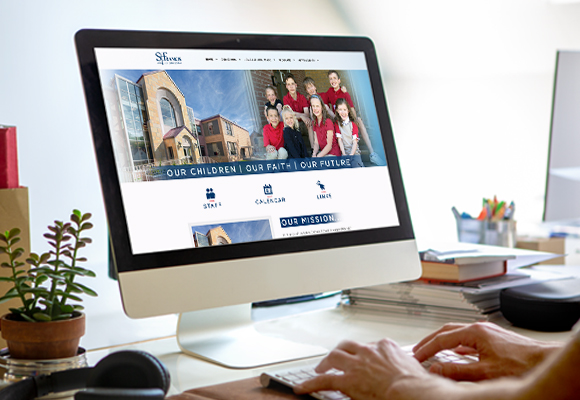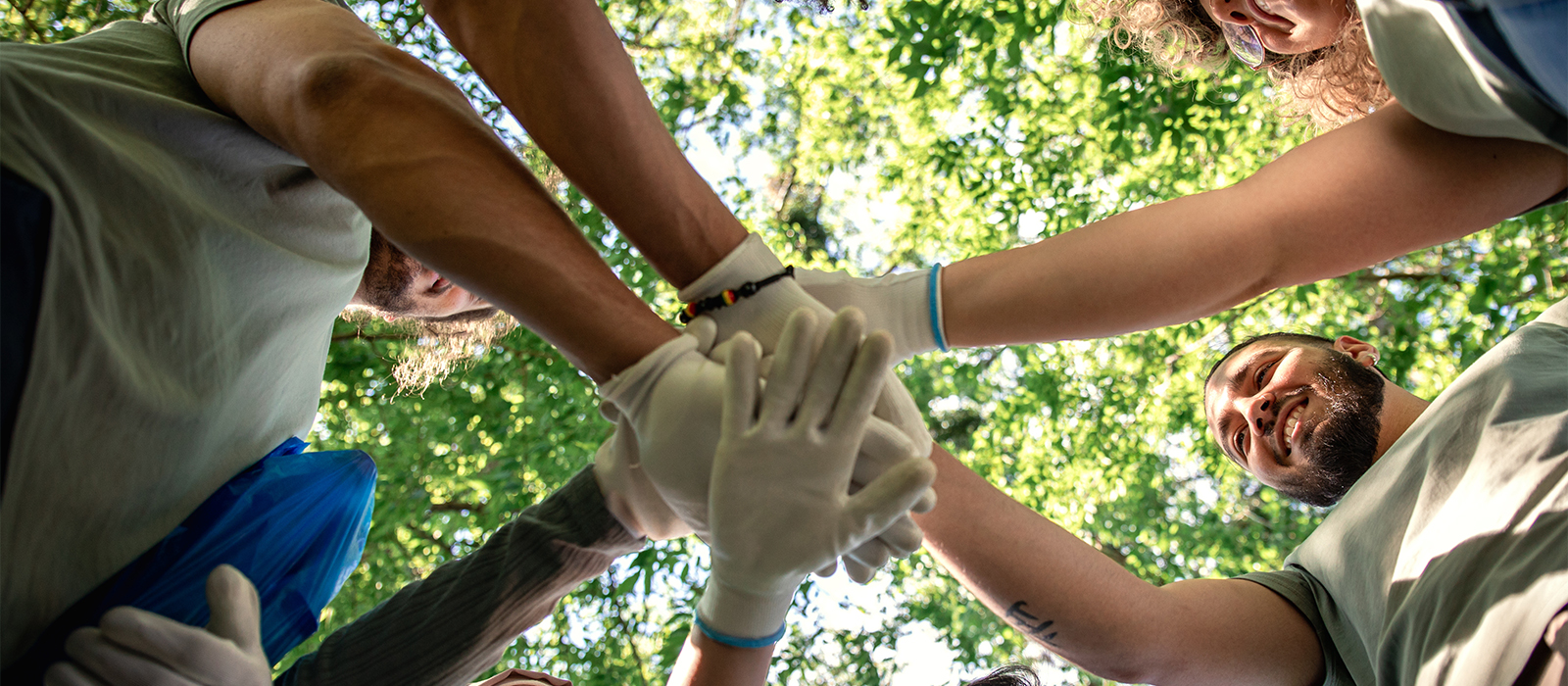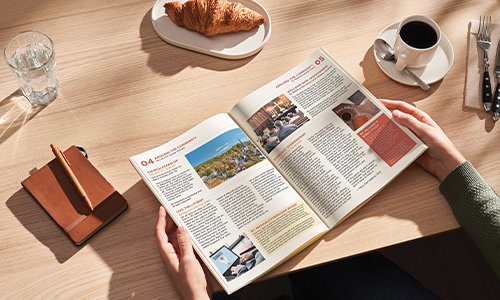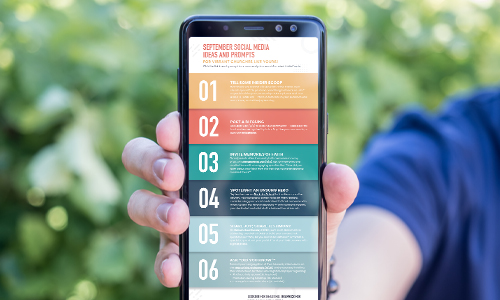In This Issue
September 2022
FEATURED ARTICLES
- Common Website Mistakes
- 5 Tips for a Better Catholic School Website
- 4 Tips to Make Your Church’s Homepage More Inviting
- Practical Ways to Recruit and Maintain Volunteers
AT-A-GLANCE

Is Your Parish Making Common Website Mistakes?
Dan Rogers from Mission by Design knows a thing or two about websites. For weeks this winter, Dan called and interviewed parishes about church websites — learning about what churches are doing, what they’re looking for, and, most importantly, how they can improve and grow.
Dan was kind enough to join us for a conversation about church websites … and common mistakes he has seen.
Q. Why do websites matter?
A. Websites matter because we live in a digital world. The internet is the primary way that people discover new restaurants, attractions, things to do on the weekends and … churches! Websites are the #1 method of communication between people of similar experiences, and they are the method by which people discover.
Q. Websites vs. social media … what’s your perspective?
A. Often parishes prioritize using websites like an online bulletin board, thinking that parishioners are logging on and seeing what’s new on a website every day. But that’s not how websites are used. Think of them more like brochures: glossy images of what you’re like or what’s inside.
Social media, text, email, those mediums are the better ways to communicate events and up-to-date stuff. Sometimes parishes get these two mediums tangled up, and it muddies the website.
Q. What should we think about when laying out a new website?
A. When laying out a website, it’s important to think about the end user and their user journey. Remember that your website exists for other people to use, not you, so make it as easy to use and as simple as possible for your visitors.
Here's an exercise: Think like a person who has never seen your website before. Who is visiting your website, and what are they looking for? Write out a few potential audiences. For instance:
- You’re a visitor getting married, where do you find information about sacraments?
- You’re someone on vacation looking for Mass times, can you find them? Are they updated?
- You’re new to town and looking for more information on where to park.
Think about common questions, common reasons that people are looking at a website.
Q. How do I know what to put on my parish site?
A. Think about what most people are looking for on your parish website.
Some ideas include:
- Mass times
- Bulletin (with up-to-date information)
- A calendar
- Ways to donate to your parish
I would say that the most important thing is pictures of people smiling. Catholicism often gets a bad rap for being a religion of heads-down, quiet prayer. We want people to see that our religion is joyful, and our community is joyful. It’s critical to talk here about fallen-away Catholics. Why might someone go to a different church? Because people seem happy there, it’s more welcoming, its more joyful. You want your church to be the one that attracts in that way.
Q. What shouldn't be on a parish website?

A.
- A picture of an empty church.
- A picture of the Mary statue.
- A picture of the outside of the church. (It can go on there, but not on the front page).
- A drone shot going over an empty church.
And I say this because: buildings are not warm and welcoming, people are. There isn’t anything wrong with statues or interiors, but they don’t convey the warmth and life of your community.
I also think that there shouldn’t be too many links to things like Catholic news or theological content. There are other websites that are updated daily with incredible theological content, let other people do that for you. And you? Focus on keeping your website simple, inviting, and easy to use.
Q. What is a common mistake that many parishes make when it comes to layout and design?
A. I have three.
First, a home page that has a big banner of text announcing an event. So, instead of seeing smiling faces I see a pixelated very big thing that says, say, “Fish Fry next Friday.” Right away that says to me, “I only care about my parishioners, and I don’t care about anyone else.” We need to be thinking about making our parish inviting and welcoming so we can fulfill the great commission.
Second, outdated information. When parishes are trying to keep up with daily updates, they can too easily become outdated. Save your daily updates for social media, email, and texting. Your large seasonal announcements can go on your website.
Third, a non-mobile friendly site. Over 55% of people are hitting your website on mobile phones. People on vacation or new to town are probably on their phone, and that is an audience you want to reach. So, you want your website to be attractive from a mobile perspective.
A friendly heads up about mobile friendly sites: Google is now actively penalizing websites that are not mobile friendly by not listing them as high in the search results. If you want your parish to grow, people need to find you, and they’re going to look on Google. Reach out to a communications savvy member of your community to ensure that your website looks good on a phone. Still stuck? LPi’s team can help build a website that is mobile friendly. Now is the time!
Q. What kinds of things belong on a parish website?
A. Some things that I love to see:
- Smiling people of different ages and backgrounds.
As a visitor, I’m looking at a picture and thinking: Will I fit in here? This is a human response to life, wondering if there is space for me in this community.
I also like to see pictures of your liturgy, pictures of your small groups, and pictures of people interacting and thriving in your parish setting. - Testimonials.
Short stories from parishioners about whey they love being a part of your parish community belong on your website. These could be as simple as, “My parish community is welcoming to my kids. I’m nervous about brining my kids to other parishes, but We’re always welcome at St. Pat’s.”
If I was a millennial and I saw and heard that, I would immediately believe them and want to bring my kids there to find out.
Q. Thank you so much! What closing thought do you have for our parishes?
A. Don’t be overwhelmed. You most likely didn’t go to school to be a professional parish web person. This might seem daunting, but you don’t have to do this alone. Look for help in your community. There are a lot of people out there who want to help — like LPi!
LPi loves helping parishes improve their web presence. If you’re interested in learning more, reach out.
Dan Roger’s company, Mission by Design, offers non-profit strategy for communications and fundraising.

EDITOR FEATURE
Hey Everyone,
I’m Chelsea, a member of the team that brings you this monthly e-newsletter along with other helpful content to build your parish community. Last month we asked if you were doing anything snazzy with your parish website. Here are a few responses we thought we’d share:
- “We redesigned our website to really showcase the character of the parish. We removed most stock images and included pictures from the church that really showcase our style of worship. As soon as you hit our homepage, you know what we're about.” -Immaculate Conception, Lapeer, MI
- “We've included our Facebook feed at the bottom of our homepage to allow those parishioners who don't use Facebook to still stay up to date with what we are posting.” -St. Patrick Catholic Church of Gretna, NE
Looking for tips to improve YOUR website? We focused on bringing you website best practices in this Vibrant Parish Newsletter.
Alright, ya’ll, let’s keep the momentum going with this month’s prompt:
- What is something that makes your parish unique?
We’re excited to read your responses!
Have a great month,
Chelsea

Five Tips for a Better Catholic School Website
What’s the secret to creating the perfect website for a Catholic school? There are a lot of factors that can make or break a website, and so much depends on the mission and culture of each individual school. Elements like content presentation and mobile friendliness, however, are universally important. Read on to find out more about those crucial factors and to explore other ways to improve your school’s online presence.
Put Catholicism Front and Center
No matter how large or small your school, staff, campus, and budget are, the very best asset offered to every student who learns there is the Good News of the Gospel. Catholic education has a lot of great selling points, but none better than the one that simply doesn’t need to be sold at all: its Christ-centered mission. Catholicism sets your school apart — celebrate that with the content and voice of your website.

Optimize Accessibility
How easy and intuitive is your site to navigate? How many clicks does it take a visitor to find contact information, mission statement and “fast facts” like enrollment and class sizes? Does your site have a prominent search window? Even simple choices like font and color scheme can impact the usability of a website. What are the load times like for your pages, and how can you lessen them? Make sure your design gets a refresh every few years to avoid getting stale and ensure that your written content is reviewed and updated with every school year. Finally, ensure that your website is set up to optimize its ranking in Google search.
Adaptability Is Key
These days, thanks to the 56% of web users who access sites on their mobile phone, it’s imperative that a website be mobile-friendly. Check to see if yours is using this link. To make sure users are able to easily and effectively access your site using mobile devices, you’ll want to make sure that the website has a design that responds well to different screen sizes, as well as an adaptive server.
Check Out Other Schools’ Websites
They say dress for the job you want, not the job you have, and the same principle applies here. Check out the sites of a school whose enrollment and mission you want to emulate. And just like a real estate agent runs comps for houses on the market, research the websites of schools that compare to yours in terms of budget, demographics, enrollment, and values. View them through the lens of a prospective parent: what compels you, piques your interest, and makes a positive impression?
Be Trendy
What’s the latest in design, content, and user experience for private school websites? Sites like CampusSuite and FinalSite offer some interesting examples of current trends like bold, creative color schemes and purposeful storytelling.
If you’re ready to tackle your website, but need a little help, see what LPi can do for you with WeConnect!

4 Tips to Make Your Church’s Homepage More Inviting
We hear it all the time, “When people visit our website, we want them to know that we are a welcoming and inviting community!” At LPi we are fortunate enough to have our own professional user experience designer, Megan, to help guide this process. When we sat down with her to ask if she had anything to share about homepage best practices, she shared four tips for parishes who want to create the most welcoming homepage user experience possible.
Tip 1: Use a HERO Image that reflects your community.
A HERO image is the first image people will see when visiting your homepage. This might be your website’s banner, background image, or simply a featured image that will be a focal point on the very first screen someone sees when navigating to your page. Consider featuring a diverse group of parishioners in this image or a snapshot of a community celebration. Images of actual members of your community instead of images of church buildings can help a potential new member envision themselves as part of your church family.
Tip 2: Collect information into easy-to-access menu groups.
Along with your hero image, visible menus with buttons should be placed directly in the visitor’s immediate line of sight. When considering how to group information items into your homepage’s menu, think about the main reasons somebody may visit your website: Mass times, ministries, contact information, Sacramental information, etc. Put the most searched for topics front and center! Lots of churches make the mistake of having too many things in their navigational menu all at once. When churches collect items into groups that are similar and present their menus more simply, this can create an easier, and thus more welcoming, homepage user experience.
Some common menu groupings that she finds successful have been:
- About | This could include your parish’s history, staff information, updated photos, media mentions, testimonials from parishioners, location, and more.
- Ministries | This menu item can lead a visitor to view a list all of your church’s ministries or even to a sub-menu of ministry categories where they can easily navigate the wonderful work your parish is doing.
- Parish Life | Use this grouping to highlight events, calendars, celebrate recent accomplishments, share photos, or make your community’s swag available to purchase.
- Sacraments | You know the ones: Baptism, Frist Communion, Confirmation, RCIA, Reconciliation, and Marriage.
- Worship | Lots can be couched under this category. Some of these items might include Mass times, prayer requests, livestreaming, Holy Day schedules, Confession times, music/choir information, Adoration times, Funeral information, and more.
- Faith Formation | This important category could also include a sub-menu for Adults, Youth, Elementary, Young Adult, Bible Studies, or any other formational programs your church offers.
- Connect | We prefer the term “connect” rather than “contact” because it can include social media, your church’s digital bulletin, staff information, a pastor’s letter, links to ministry newsletters, all alongside the parish’s general contact information.
Tip 3: Use good quality images
Quality imagery is super important in making your homepage look inviting to new visitors. Sometimes churches make the mistake of relying on old or grainy pictures, or they depend too much on stock imagery instead of featuring their actual community. Having vibrant, up to date imagery of your church, real parishioners, and events/holidays is one of the simplest ways to make your website more engaging and welcoming. LPi has an extensive library of professional images available for you to use on your website via WeCreate, our art and content tool.
Tip 4: Don’t forget about cell phones!
It is pivotal that your homepage looks good on mobile phones and other mobile devices. Statistically speaking, recent data suggests that over half of all visits to a church’s website are from phones and tablets. Don’t believe us? Check out some statistics here. At LPi we find that 68% of our website visits come from mobile devices! This means that you should expect that at least half of your visitors will be using their phone to view your content as well. Your homepage should be designed to be attractive and easy to use when someone navigates to it via their cell.
At LPi we have incredible people like Megan and an experienced digital design team that works with parishes to create branding tools and resources to get your homepage, social media, bulletin, and over-all visual parish identity dialed in. We also have a vast library of ready-made images and tools for you to create your own, custom, high resolution imagery to use on any digital or printed resource you may have.
To put these four tips to use and to create the most welcoming homepage and inviting digital experience for potential new parishioners, contact our team to see how we can give your online presence a refresh. Find out more information here.

Practical Ways to Recruit and Maintain Volunteers
Volunteers provide numerous vital services for parishes. Recruiting and maintaining a consistent volunteer corps may require some creativity. Beginning with identifying parish needs, recognizing groups and individuals available to whom you can reach out, and most importantly, helping parishioners discern how their particular gifts and talents can bless the Church and the community. There are certain liturgical seasons, like Advent and Lent, when parishes may find an uptick in those interested in volunteering. It’s good to optimize those times to encourage assistance with charitable and parish activities throughout the year. Introduce a variety of volunteer opportunities so those men, women, and even families will continue to serve well beyond the season.
One strategy for achieving success in creating a core of dedicated volunteers comes from offering a wide range of volunteering opportunities. Brainstorming a list of all the tasks throughout the year requiring extra hands is pivotal. Parishes can then find ways to tap into people's gifts and talents. Consider adopting a broader definition of volunteer work beyond collecting donations, teaching in your religious education programs, and serving at Mass in order to engage a larger potential volunteer population.
Thinking Outside the Volunteer Box
Not everyone may feel comfortable to assist in the more spiritual activities of a parish — they may even consider themselves unworthy. Why not begin with the parish's building and facilities needs such as snow removal, raking leaves, window washing, and even floor-sweeping to help parishioners understand that they can be of great use to the church in many capacities outside of the traditional spiritual activities. Does your parish have a small clerical staff? Could the parish use assistance with filing, email sending, or contact collection? What about phone calls or emails for pastoral outreach, follow-up on missing sacrament forms or inquiries, or assisting families to complete registration forms for your faith formation programs.
There are many ways to open people's hearts to the possibilities of sharing their unique gifts and talents. Try to introduce how someone may be able to bless the parish through singing, crafting, graphic design, managing social media, formatting the weekly bulletin, or organizing parish fundraising and social events!

Help Wanted Description
Make sure to create a clear summary of each role and duty. Be clear about the time commitment, skills, and talents that you are seeking for the role, and of course be sure to share if there are any benefits! After all, who wouldn't show up for a free meal after volunteering?
Once you have a description, share it in the bulletin, mailings, parish website, social media, and any other avenues of communication your church has. Rotate the "wanted ads" and consider including testimonies from new and current volunteers. These types of testimonials can be great during Mass announcements as well!
Don't Overlook the Little Things
Here's an example of how a parish embraced one woman's desire to volunteer although she initially felt that she was inadequate to serve. She shared with the Director of Religious Education how embarrassed she felt when volunteers were sought at meetings, especially when asked to help provide food for parish events. Cooking and baking were not within her gifts or talents. The DRE suggested finding something else that might be needed for the event, something that she could buy instead of cook. Taking this advice, she chose to start supplying the potato chips for events at the parish.
After a while, the woman’s donation of potato chips became what the DRE would refer to as the woman's "secret recipe," particularly when requesting the item in front of other parents. The woman reported that this simple gesture helped her to see how she could easily contribute in a meaningful way, and over time, she found even more ways to contribute to the parish.
The Great Commission
Every church is unique. Each has different demographics, programming, charisms, and missions. One thing that stays consistent throughout, though, is that volunteerism is foundational to the mission of Christianity. Remember, the Great Commission calls each of us to be part of the whole Body of Christ. Creating a sound strategy to recruit and maintain volunteers provides the Church with an opportunity to assist our members in answering that timeless call. After all, we’re in this together!
For more information on guiding parishioners toward discerning their gifts, check out the Strengthsfinder white papers on our Resources page.
ALSO FROM LPi

Beautiful Catholic Graphics
WeCreate is a graphics library featuring beautiful depictions of Catholic liturgical life. Use the art in your print or digital media!

Become a Bulletin Customer
Spend less time worrying about your church printing and more time transforming your community for Christ.

Branding Matters
A good brand invites parishioners and seekers into the mission of your church, helping everyone to grow in faith, live in hope, and reach out in the love of Jesus Christ.

FREE Social Media Ideas
Social media offers a great way to communicate with your parishioners. Not sure what to post? Here are ideas to flesh out your month!
In This Issue
September 2022
FEATURED ARTICLES
- Common Website Mistakes
- Editor Feature
- 5 Tips for a Better Catholic School Website
- 4 Tips to Make Your Church’s Homepage More Inviting
- Practical Ways to Recruit and Maintain Volunteers
ALSO FROM LPi
More resources
- DIGITAL CATHOLIC ART & CONTENT FOR EVERY WEEK
With WeCreate, you’ll find the latest in stock photography, church clip art, Catholic prayers, weekly Gospel reflections, and more to make your communications engaging and vibrant.
Learn more - HOW TO TAKE MASS ATTENDANCE IN A PANDEMIC
Discover how the Archdiocese of St. Louis showed that just because church doors were closed, didn’t necessarily mean the faith community was inaccessible.
Click here to learn more. - THE STEWARDSHIP OF THE GOOD SAMARITAN
”Are you and I required to respond to the daily call of Jesus Christ? No. True stewardship requires nothing of us because true stewardship is all about giving of oneself freely. ”
Click here to read more.
